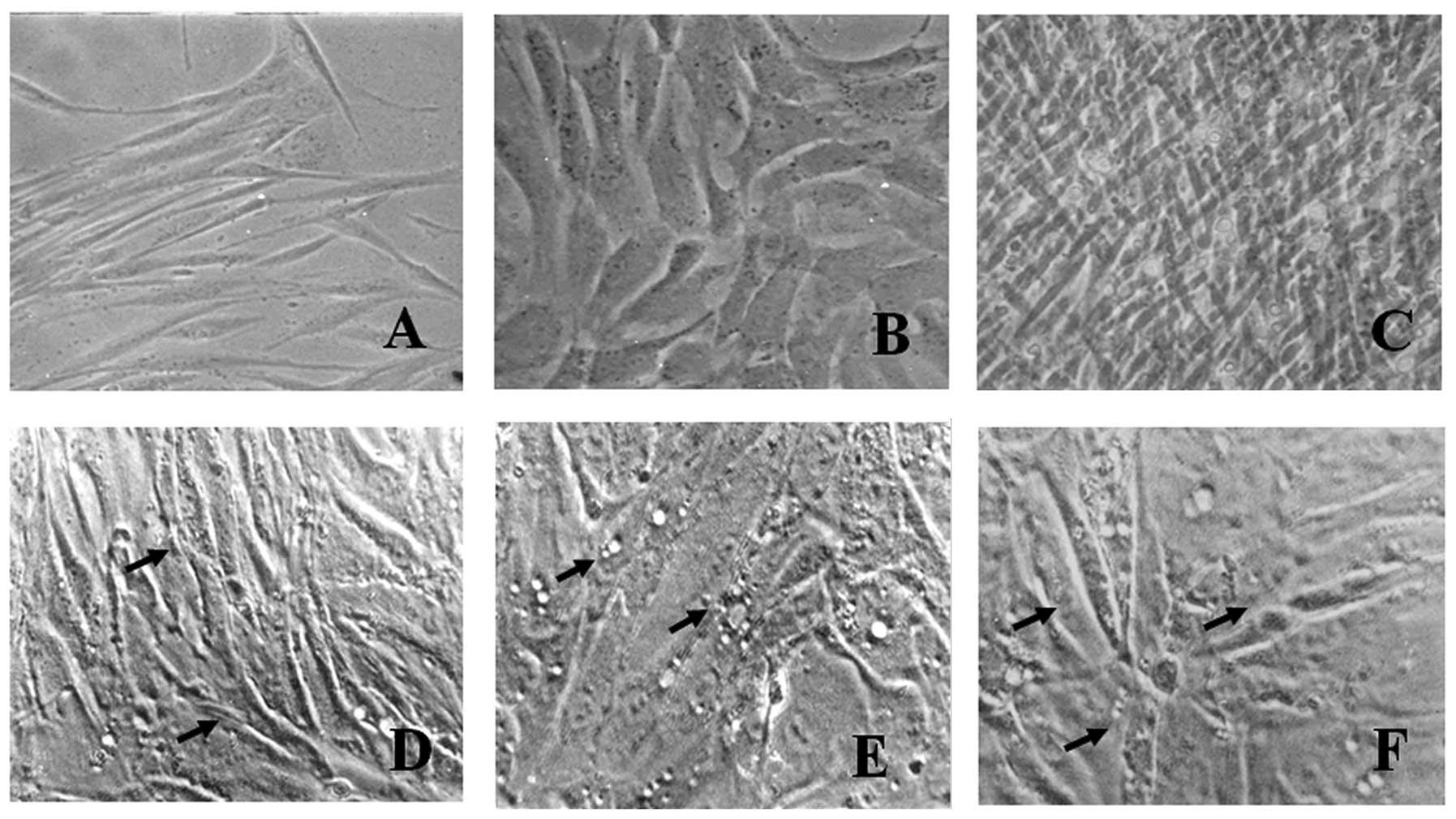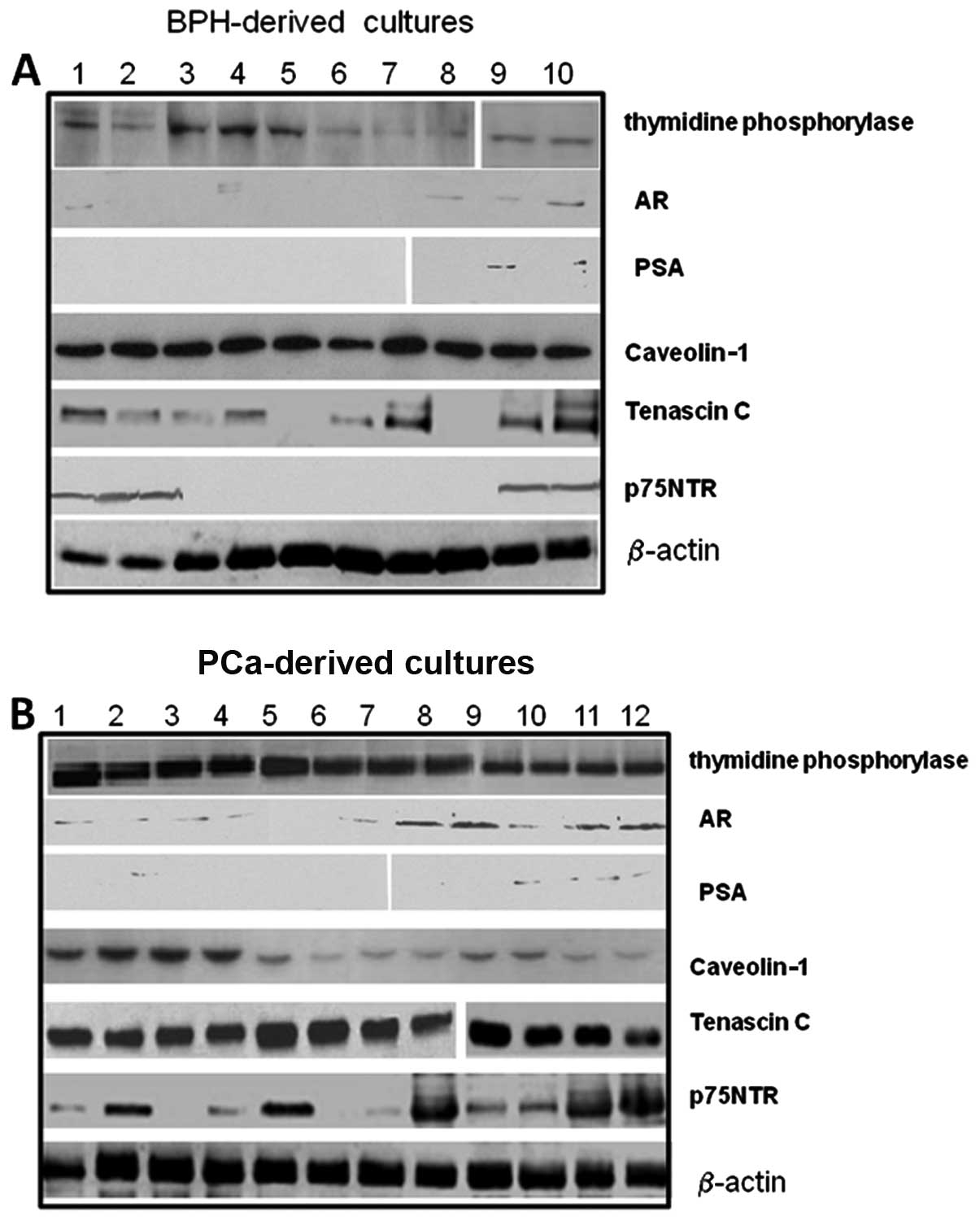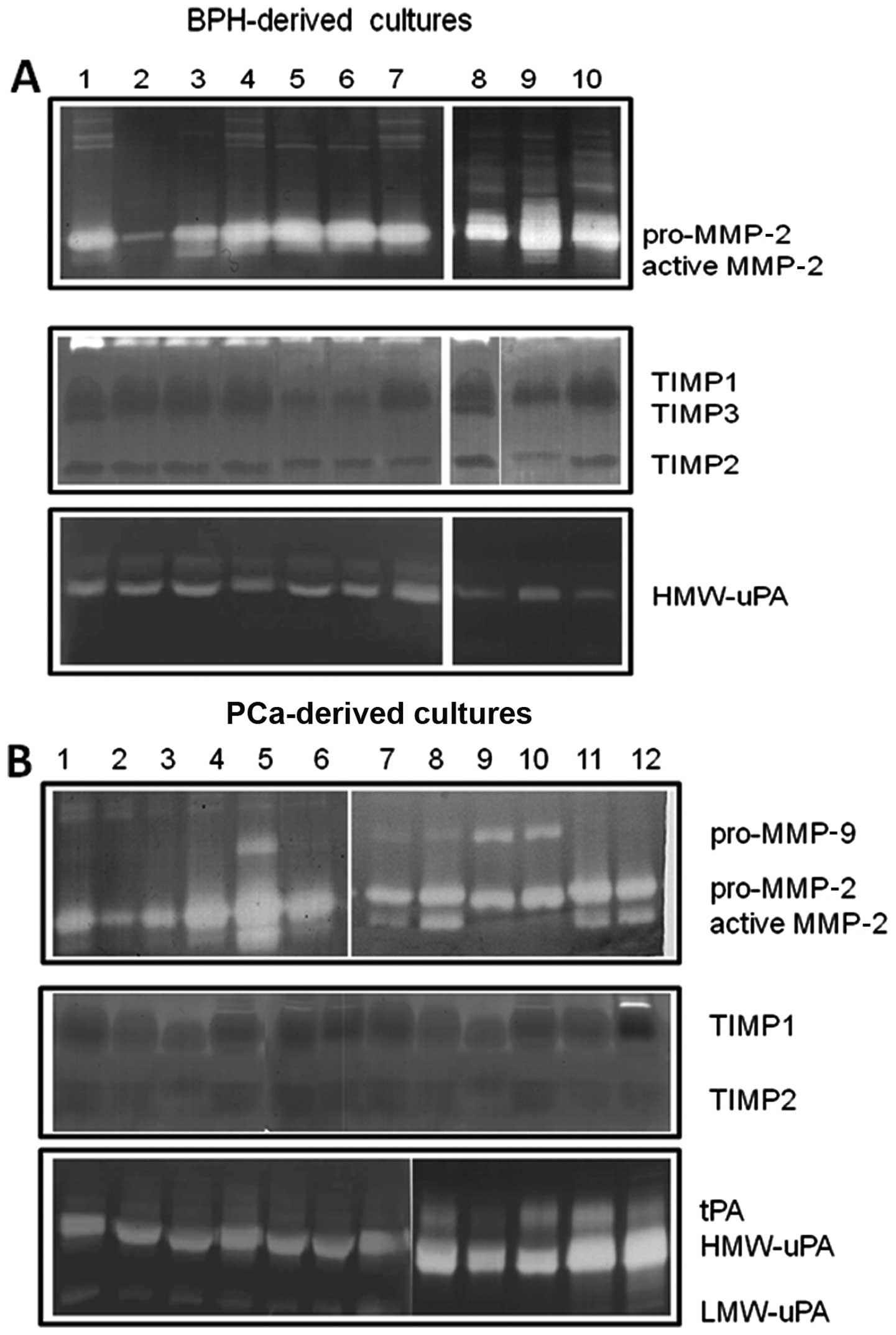|
1
|
Barron DA and Rowley DR: The reactive
stroma microenvironment and prostate cancer progression. Endocr
Relat Cancer. 19:R187–R204. 2012. View Article : Google Scholar : PubMed/NCBI
|
|
2
|
Ammirante M, Luo JL, Grivennikov S,
Nedospasov S and Karin M: B-cell-derived lymphotoxin promotes
castration-resistant prostate cancer. Nature. 464:302–305. 2010.
View Article : Google Scholar : PubMed/NCBI
|
|
3
|
Iacopino F, Angelucci C and Sica G:
Interactions between normal human fibroblasts and human prostate
cancer cells in a co-culture system. Anticancer Res. 32:1579–1588.
2012.PubMed/NCBI
|
|
4
|
Grubisha MJ, Cifuentes ME, Hammes SR and
Defranco DB: A local paracrine and endocrine network involving
TGFβ, Cox-2, ROS, and estrogen receptor β influences reactive
stromal cell regulation of prostate cancer cell motility. Mol
Endocrinol. 26:940–954. 2012.PubMed/NCBI
|
|
5
|
Hayward SW, Wang Y, Cao M, Hom YK, Zhang
B, Grossfeld GD, Sudilovsky D and Cunha GR: Malignant
transformation in a nontumorigenic human prostatic epithelial cell
line. Cancer Res. 61:8135–8142. 2001.PubMed/NCBI
|
|
6
|
Cunha GR, Hayward SW, Wang YZ and Ricke
WA: Role of the stromal microenvironment in carcinogenesis of the
prostate. Int J Cancer. 107:1–10. 2003. View Article : Google Scholar : PubMed/NCBI
|
|
7
|
Olumi AF, Grossfeld GD, Hayward SW,
Carroll PR, Tlsty TD and Cunha GR: Carcinoma-associated fibroblasts
direct tumor progression of initiated human prostatic epithelium.
Cancer Res. 59:5002–5011. 1999.PubMed/NCBI
|
|
8
|
Barclay WW, Woodruff RD, Hall MC and
Cramer SD: A system for studying epithelial-stromal interactions
reveals distinct inductive abilities of stromal cells from benign
prostatic hyperplasia and prostate cancer. Endocrinology.
146:13–18. 2005. View Article : Google Scholar
|
|
9
|
Ricke EA, Williams K, Lee YF, Couto S,
Wang Y, Hayward SW, Cunha GR and Ricke WA: Androgen hormone action
in prostatic carcinogenesis: stromal androgen receptors mediate
prostate cancer progression, malignant transformation and
metastasis. Carcinogenesis. 33:1391–1398. 2012. View Article : Google Scholar
|
|
10
|
Tanner MJ, Welliver RC Jr, Chen M,
Shtutman M, Godoy A, Smith G, Mian BM and Buttyan R: Effects of
androgen receptor and androgen on gene expression in prostate
stromal fibroblasts and paracrine signaling to prostate cancer
cells. PLoS One. 6:e160272011. View Article : Google Scholar : PubMed/NCBI
|
|
11
|
Lai KP, Yamashita S, Huang CK, Yeh S and
Chang C: Loss of stromal androgen receptor leads to suppressed
prostate tumourigenesis via modulation of pro-inflammatory
cytokines/chemokines. EMBO Mol Med. 4:791–807. 2012. View Article : Google Scholar : PubMed/NCBI
|
|
12
|
Li X, Sterling JA, Fan KH, Vessella RL,
Shyr Y, Hayward SW, Matrisian LM and Bhowmick NA: Loss of TGF-β
responsiveness in prostate stromal cells alters chemokine levels
and facilitates the development of mixed osteoblastic/osteolytic
bone lesions. Mol Cancer Res. 10:494–503. 2012.
|
|
13
|
Delsite R and Djakiew D: Characterization
of nerve growth factor precursor protein expression by human
prostate stromal cells: a role in selective neurotrophin
stimulation of prostate epithelial cell growth. Prostate. 41:39–48.
1999. View Article : Google Scholar
|
|
14
|
Krygier S and Djakiew D: The neurotrophin
receptor p75NTR is a tumor suppressor in human prostate cancer.
Anticancer Res. 21:3749–3755. 2001.PubMed/NCBI
|
|
15
|
Festuccia C, Gravina GL, Muzi P, Pomante
R, Ventura L, Ricevuto E, Vicentini C and Bologna M: In vitro and
in vivo effects of bicalutamide on the expression of TrkA and P75
neurotrophin receptors in prostate carcinoma. Prostate.
67:1255–1264. 2007. View Article : Google Scholar : PubMed/NCBI
|
|
16
|
Rende M, Rambotti MG, Stabile AM, Pistilli
A, Montagnoli C, Chiarelli MT and Mearini E: Novel localization of
low affinity NGF receptor (p75) in the stroma of prostate cancer
and possible implication in neoplastic invasion: an
immunohistochemical and ultracytochemical study. Prostate.
70:555–561. 2010.PubMed/NCBI
|
|
17
|
Festuccia C, Vincentini C, di Pasquale AB,
Aceto G, Zazzeroni F, Miano L and Bologna M: Plasminogen activator
activities in short-term tissue cultures of benign prostatic
hyperplasia and prostatic carcinoma. Oncol Res. 7:131–138.
1995.PubMed/NCBI
|
|
18
|
Festuccia C, Angelucci A, Gravina GL, Muzi
P, Miano R, Vicentini C and Bologna M: Epithelial and prostatic
marker expression in short-term primary cultures of human prostate
tissue samples. Int J Oncol. 26:1353–1362. 2005.PubMed/NCBI
|
|
19
|
Sugimoto H, Mundel TM, Kieran MW and
Kalluri R: Identification of fibroblast heterogeneity in the tumor
microenvironment. Cancer Biol Ther. 5:1640–1646. 2006. View Article : Google Scholar : PubMed/NCBI
|
|
20
|
De Wever O, Demetter P, Mareel M and
Bracke M: Stromal myofibroblasts are drivers of invasive cancer
growth. Int J Cancer. 123:2229–2238. 2008.PubMed/NCBI
|
|
21
|
Festuccia C, Angelucci A, Gravina G,
Eleuterio E, Vicentini C and Bologna M: Bombesin-dependent
pro-MMP-9 activation in prostatic cancer cells requires beta1
integrin engagement. Exp Cell Res. 280:1–11. 2002. View Article : Google Scholar : PubMed/NCBI
|
|
22
|
Festuccia C, Dolo V, Guerra F, et al:
Plasminogen activator system modulates invasive capacity and
proliferation in prostatic tumor cells. Clin Exp Metastasis.
16:513–528. 1998. View Article : Google Scholar : PubMed/NCBI
|
|
23
|
Schor SL, Schor AM and Rushton G:
Fibroblasts from cancer patients display a mixture of both foetal
and adult-like phenotypic characteristics. J Cell Sci. 90:401–407.
1988.PubMed/NCBI
|
|
24
|
Reinertsen T, Halgunset J, Viset T,
Flatberg A, Haugsmoen LL and Skogseth H: Gene expressional changes
in prostate fibroblasts from cancerous tissue. APMIS. 120:558–571.
2012. View Article : Google Scholar : PubMed/NCBI
|
|
25
|
Cifone MG, Botti D, Festuccia C,
Napolitano T, del Grosso E, Cavallo G, Chessa MA and Santoni A:
Involvement of phospholipase A2 activation and arachidonic acid
metabolism in the cytotoxic functions of rat NK cells. Cell
Immunol. 148:247–258. 1993. View Article : Google Scholar : PubMed/NCBI
|
|
26
|
Ayala G, Tuxhorn JA, Wheeler TM, et al:
Reactive stroma as a predictor of biochemical- free recurrence in
prostate cancer. Clin Cancer Res. 9:4792–4801. 2003.PubMed/NCBI
|
|
27
|
McAlhany SJ, Ayala GE, Frolov A, et al:
Decreased stromal expression and increased epithelial expression of
WFDC1/ps20 in prostate cancer is associated with reduced
recurrence-free survival. Prostate. 61:182–191. 2004. View Article : Google Scholar
|
|
28
|
Orimo A, Gupta PB, Sgroi DC, et al:
Stromal fibroblasts present in invasive human breast carcinomas
promote tumor growth and angiogenesis through elevated SDF-1/CXCL12
secretion. Cell. 121:335–348. 2005. View Article : Google Scholar
|
|
29
|
Rowley DR: What might a stromal response
mean to prostate cancer progression? Cancer Metastasis Rev.
17:411–419. 1998. View Article : Google Scholar : PubMed/NCBI
|
|
30
|
Tuxhorn JA, McAlhany SJ, Dang TD, Ayala GE
and Rowley DR: Stromal cells promote angiogenesis and growth of
human prostate tumors in a differential reactive stroma (DRS)
xenograft model. Cancer Res. 62:3298–3307. 2002.PubMed/NCBI
|
|
31
|
Thalmann GN, Rhee H, Sikes RA, Pathak S,
Multani A, Zhau HE, Marshall FF and Chung LW: Human prostate
fibroblasts induce growth and confer castration resistance and
metastatic potential in LNCaP cells. Eur Urol. 58:162–171. 2009.
View Article : Google Scholar : PubMed/NCBI
|
|
32
|
Goetz JG, Minguet S, Navarro-Lérida I,
Lazcano JJ, Samaniego R, Calvo E, et al: Biomechanical remodeling
of the microenvironment by stromal caveolin-1 favors tumor invasion
and metastasis. Cell. 146:148–163. 2011. View Article : Google Scholar : PubMed/NCBI
|
|
33
|
Giatromanolaki A, Koukourakis MI,
Koutsopoulos A, Mendrinos S and Sivridis E: The metabolic
interactions between tumor cells and tumor-associated stroma (TAS)
in prostatic cancer. Cancer Biol Ther. 13:Nov 1–2012, (Epub ahead
of print).
|
|
34
|
Freeman MR, Yang W and Di Vizio D:
Caveolin-1 and prostate cancer progression. Adv Exp Med Biol.
729:95–110. 2012. View Article : Google Scholar : PubMed/NCBI
|
|
35
|
Giannoni E, Taddei ML, Parri M, Bianchini
F, Santosuosso M, Grifantini R, Fibbi G, Mazzanti B, Calorini L and
Chiarugi P: EphA2-mediated mesenchymal-amoeboid transition induced
by endothelial progenitor cells enhances metastatic spread due to
cancer-associated fibroblasts. J Mol Med (Berl). Aug 19–2012, (Epub
ahead of print).
|
|
36
|
Franco OE, Shaw AK, Strand DW and Hayward
SW: Cancer associated fibroblasts in cancer pathogenesis. Semin
Cell Dev Biol. 21:33–39. 2010. View Article : Google Scholar : PubMed/NCBI
|
|
37
|
Daja MM, Niu X, Zhao Z, Brown JM and
Russell PJ: Characterization of expression of matrix
metalloproteinases and tissue inhibitors of metalloproteinases in
prostate cancer cell lines. Prostate Cancer Prostatic Dis. 6:15–26.
2003. View Article : Google Scholar : PubMed/NCBI
|
|
38
|
Wilson MJ, Sellers RG, Wiehr C, Melamud O,
Pei D and Peehl DM: Expression of matrix metalloproteinase-2 and -9
and their inhibitors, tissue inhibitor of metalloproteinase-1 and
-2, in primary cultures of human prostatic stromal and epithelial
cells. J Cell Physiol. 191:208–216. 2002. View Article : Google Scholar
|
|
39
|
Zhang J, Jung K, Lein M, Kristiansen G,
Rudolph B, Hauptmann S, Schnorr D, Loening SA and Lichtinghagen R:
Differential expression of matrix metalloproteinases and their
tissue inhibitors in human primary cultured prostatic cells and
malignant prostate cell lines. Prostate. 50:38–45. 2002. View Article : Google Scholar
|













